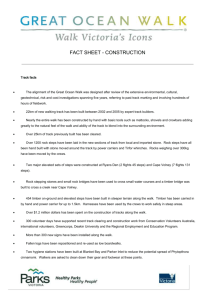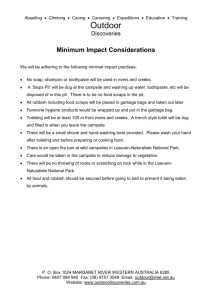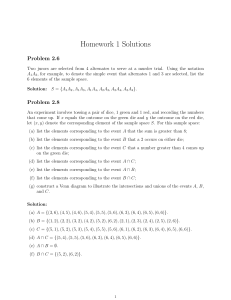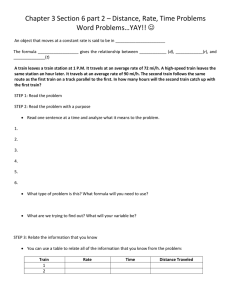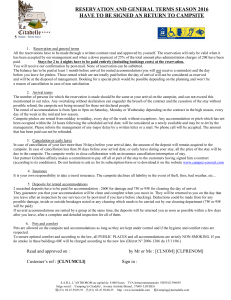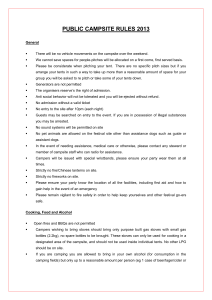An Evaluation of Physical Impacts in Backcountry Camping Areas at ABSTRACT
advertisement
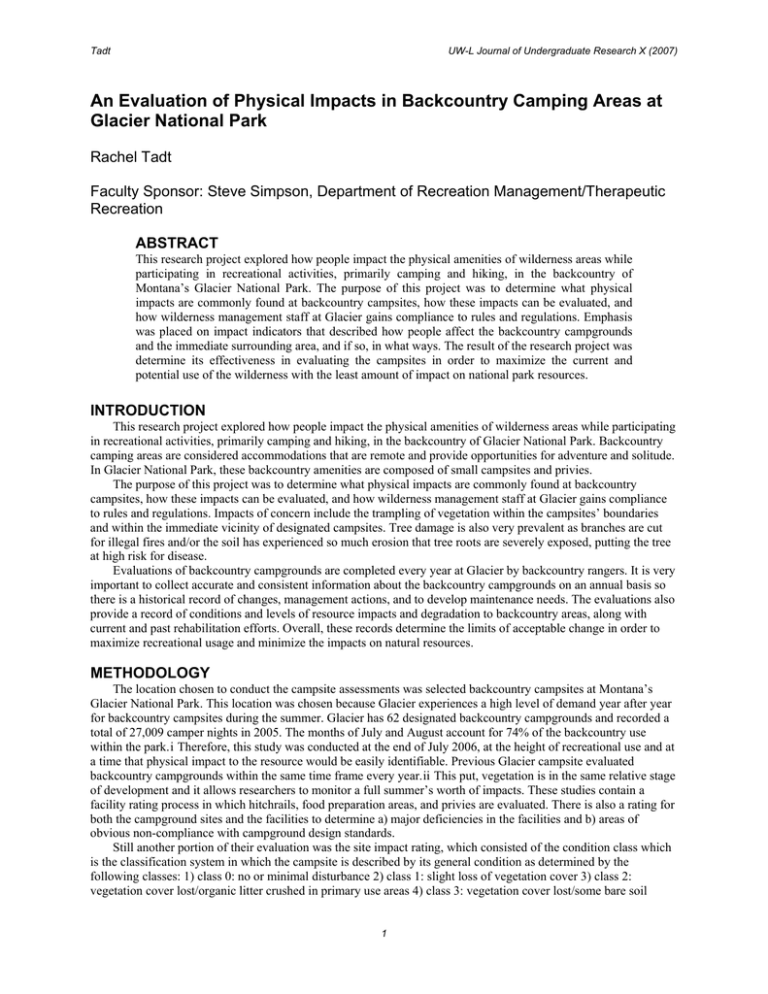
Tadt UW-L Journal of Undergraduate Research X (2007) An Evaluation of Physical Impacts in Backcountry Camping Areas at Glacier National Park Rachel Tadt Faculty Sponsor: Steve Simpson, Department of Recreation Management/Therapeutic Recreation ABSTRACT This research project explored how people impact the physical amenities of wilderness areas while participating in recreational activities, primarily camping and hiking, in the backcountry of Montana’s Glacier National Park. The purpose of this project was to determine what physical impacts are commonly found at backcountry campsites, how these impacts can be evaluated, and how wilderness management staff at Glacier gains compliance to rules and regulations. Emphasis was placed on impact indicators that described how people affect the backcountry campgrounds and the immediate surrounding area, and if so, in what ways. The result of the research project was determine its effectiveness in evaluating the campsites in order to maximize the current and potential use of the wilderness with the least amount of impact on national park resources. INTRODUCTION This research project explored how people impact the physical amenities of wilderness areas while participating in recreational activities, primarily camping and hiking, in the backcountry of Glacier National Park. Backcountry camping areas are considered accommodations that are remote and provide opportunities for adventure and solitude. In Glacier National Park, these backcountry amenities are composed of small campsites and privies. The purpose of this project was to determine what physical impacts are commonly found at backcountry campsites, how these impacts can be evaluated, and how wilderness management staff at Glacier gains compliance to rules and regulations. Impacts of concern include the trampling of vegetation within the campsites’ boundaries and within the immediate vicinity of designated campsites. Tree damage is also very prevalent as branches are cut for illegal fires and/or the soil has experienced so much erosion that tree roots are severely exposed, putting the tree at high risk for disease. Evaluations of backcountry campgrounds are completed every year at Glacier by backcountry rangers. It is very important to collect accurate and consistent information about the backcountry campgrounds on an annual basis so there is a historical record of changes, management actions, and to develop maintenance needs. The evaluations also provide a record of conditions and levels of resource impacts and degradation to backcountry areas, along with current and past rehabilitation efforts. Overall, these records determine the limits of acceptable change in order to maximize recreational usage and minimize the impacts on natural resources. METHODOLOGY The location chosen to conduct the campsite assessments was selected backcountry campsites at Montana’s Glacier National Park. This location was chosen because Glacier experiences a high level of demand year after year for backcountry campsites during the summer. Glacier has 62 designated backcountry campgrounds and recorded a total of 27,009 camper nights in 2005. The months of July and August account for 74% of the backcountry use within the park.i Therefore, this study was conducted at the end of July 2006, at the height of recreational use and at a time that physical impact to the resource would be easily identifiable. Previous Glacier campsite evaluated backcountry campgrounds within the same time frame every year.ii This put, vegetation is in the same relative stage of development and it allows researchers to monitor a full summer’s worth of impacts. These studies contain a facility rating process in which hitchrails, food preparation areas, and privies are evaluated. There is also a rating for both the campground sites and the facilities to determine a) major deficiencies in the facilities and b) areas of obvious non-compliance with campground design standards. Still another portion of their evaluation was the site impact rating, which consisted of the condition class which is the classification system in which the campsite is described by its general condition as determined by the following classes: 1) class 0: no or minimal disturbance 2) class 1: slight loss of vegetation cover 3) class 2: vegetation cover lost/organic litter crushed in primary use areas 4) class 3: vegetation cover lost/some bare soil 1 Tadt UW-L Journal of Undergraduate Research X (2007) exposed 5) class 4: nearly complete or total loss of vegetation cover 6) class 5: soil erosion was obvious with exposed tree roots & rocks. The second indicator was the estimate of the percentage natural, live non-woody vegetative ground cover within the campsite boundaries. The estimates were determined by the following percentages: 0-5% 6-25% 51-75% 76-95% 96-100%. The third indicator were access trails which are a count of all unofficial, human-caused trails leading away from the outer campsite boundaries. The number of separate trails at a distance of 10 feet from campsite boundaries was counted. The intent was to determine the extent to which people wander and travel in undesignated areas. The next indicator was tree damage that was observed. The amount of damage was determined by a tally of each live tree (>1 in. diameter at 4.5 feet in height) within or on campsite boundaries that displayed damage. Damage included was clearly human-caused based on following criteria: None: No/slight damage Moderate: Scars that total more than 1 x 2 inches Severe: Scars that total more than 6 x 6 inches. The estimated percentage of exposed soil in each campsite was the next indicator, defined as ground devoid of vegetation, litter or other organic matter within the campsite boundaries described by these categories: 0-5% 6-25% 51-75% 7695% 96-100%. Illegal fire sites were determined by a count of each fire site within campsite boundaries in campgrounds where campfires are not allowed. This included old inactive fire sites as exhibited by blackened rocks, charcoal, or ashes. Trash and litter were evaluated by estimating a percentage of a single garbage bag (40 gallon size) or number of bags that could be filled with recreation-related litter from the campsite. The last impact indicator was human waste sites when a count of the number of individual human waste sites was recorded. The intent was to identify the extent to which improperly disposed human feces are a problem. This specific study evaluated three backcountry campgrounds within a five day period. The first campground was Synder Lake, located on the west side of the park, where campers spent a total of 188 nights, out of an available 453. The other two campgrounds were on the east side of the park. One was Upper Two Medicine Lake, which experienced camper total nights of 237 out of 627 available. The final campground, No Name Lake, campers spent 240 nights camping from total available nights of 601. All numbers were recorded in 2005, and all three were ranked in the top twenty of the most used campgrounds.iii The campsites were evaluated using methods cited in the Campsite Monitoring Handbook, an instrument previously used and adapted for my research at Glacier National Park. ivTo begin the evaluations, inventory on the campsite was taken and each campsite was given a number for future reference. Inventory criteria included whether the campsite was contained in wilderness, how the campsite is accessed, and whether it was an individual or group campsite. Other criteria include the stay limit, whether campfires are permitted, if there was a picnic table present and the number of obvious tent pads from repeated use of campers. Understanding of the setting and amount of vegetation in and around the campground is also very important. These types of indicators can assist in understanding the results of the evaluations. These types of indicators include whether or not the site was visible from the campground trail, and also if the site was visible from the formal park trail. The amount of tree canopy cover that shaded each campsite was also estimated. Each campground and the campsites’ evaluations took approximately an hour to complete. After evaluations on the west side campground were completed, interviews with the wilderness manager of Glacier National Park were conducted. Specific issues that were brought up during my time in the field with the backcountry ranger were discussed, along with the resource management methods used in the backcountry. Also discussed was the creation of the current campground evaluation methods and its effectiveness in evaluating the campsites in order to maximize the potential use of the wilderness with the least amount of impact on park resources. RESULTS Nine campsite evaluations from three backcountry campgrounds within Glacier National Park were completed. There were three separated, designated campsites at each campground. Synder Lake Campground is located on the west side of the national park, approximately 4.4 miles from the trailhead. At campsite one, the condition was rated at a two with 26-50% vegetation ground cover. Approximately 6-25% of the designated campsite had exposed soil, with none/slight tree damage. Around the campsite, 2 access trails were identified, with no illegal campfire sites found. No litter or trash was evident and one human waste site was located. At campsite two, the condition class was rated at a two with 26-50% vegetation ground cover. Approximately 6-25% of the designated campsite had exposed soil, with moderate tree damage. Around the campsite, 2 access trails were identified, with no illegal campfire sites found. No litter or human waste sites were found. 2 Tadt UW-L Journal of Undergraduate Research X (2007) At campsite three, the condition was also rated at a two with 26-50% vegetation ground cover. Approximately 0-5% of the designated campsite had exposed soil, with none/slight tree damage. Around the campsite, 2 access trails were identified, with one illegal campfire site found. No litter or human waste sites were noted. Upper Two Medicine Lake Campground is located on the southeast side of the national park, approximately 4.6 miles from the trailhead. At campsite one, the condition class was rated at a one with 0-5% vegetation ground cover. Approximately 6-25% of the designated campsite had exposed soil, with none/slight tree damage. Around the campsite, 1 access trail was identified, with one illegal campfire site found. No litter or human waste sites were evident. At campsite two, the condition class was rated at a three with 0-5% vegetation ground cover. Approximately 625% of the designated campsite had exposed soil, with none/slight tree damage. Around the campsite, 1 access trail was identified, with one illegal campfire site found. No litter or human waste sites were located. At campsite three, the condition class was rated at a three with 0-5% vegetation ground cover. Approximately 26-50% of the designated campsite had exposed soil, with moderate tree damage. Around the campsite, 1 access trail was identified, with no illegal campfire sites found. No litter or human waste sites were found. No Name Lake Campground is located on the southeast side of the national park, approximately 5 miles from the trailhead. At campsite one, the condition class was rated at a one with 6-25% vegetation ground cover. Approximately 26-50% of the designated campsite had exposed soil, with none/slight tree damage. Around the campsite, no access trails or illegal campfire sites were found. No litter or human waste sites were noted. At campsite two, the condition class was rated at a three with 0-5% vegetation ground cover. Approximately 26-50% of the designated campsite had exposed soil, with none/slight tree damage. Around the campsite, no access trails or illegal campfire sites were found. No litter or human waste sites were evident. At campsite three, the condition class was rated at a five with 0-5% vegetation ground cover. Approximately 51-75% of the designated campsite had exposed soil, with moderate tree damage. Around the campsite, no access trails were identified, with one illegal campfire site found. No litter or human waste sites were located. DISCUSSION After evaluation each individual campsite, the results of the each individual campsite was combined to determine overall impacts. Relating to the condition class, the general classification system of each campsite, I had five campsites that were rated Class 2, three campsites were Class 3, and one campsite was rated Class 5. The vegetative ground cover onsite results indicated five campsites had 0-5% cover, one campsite had 6-25% cover, two campsites had 26-50% cover, and one campsite had 51-75% cover. The tree damage found onsite was very minimal; six campsites had no damage, whereas three campsites had moderate damage. The results of the estimate of exposed soil where very spread out. One campsite had 0-5% exposure, four campsites had 6-25% exposure, three campsites had 26-50% exposure, and 1 campsite had 51-75% exposure. Access trails leading from the campsites were common. Three campsites had no trails, two campsites had 1 trail and 4 campsites had 2 trails. There were three campsites that one illegal fire site, and six campsites no sites. Human waste sites were found; two campsites had 1 site, and seven campsites had no sites. These evaluations also revealed that no litter/trash sites were discovered. This aspect is difficult to evaluate though because constant maintenance is performed by park staff, which includes picking up any trash found. Therefore, the fact that no trash was found can be contributed to any recent visits by staff. LIMITATIONS Although the data collected has indicated impacts on the campsites there are two factors that make it difficult to determine concrete conclusions on the overall condition of the backcountry throughout Glacier National Park. The first factor is the amount of campgrounds that were evaluated. There are sixty-two backcountry campgrounds within Glacier National Park, and this research only reflects a small portion of the campgrounds. The research does not accurately reflect the park and its campgrounds as a whole. More researchers and a larger amount of time would increase the amount of evaluations that could be conducted, in turn gaining a better representation of the park. Another factor were the campgrounds that were chosen are all four and a half miles or less from the trail head, making them popular day hikes. The day hikers are not required to view the Introduction to Backcountry Camping video, which is required of all those who purchase a backcountry camping permit. Therefore, day hikers are often not educated in and/or practice the proper etiquette in the backcountry. In conclusion, there will always be impacts where wilderness areas are accessed by humans for recreational use. What is important is how much are they impacted, and how can changes be made to lessen those impacts. 3 Tadt UW-L Journal of Undergraduate Research X (2007) Information obtained will determine carrying capacities in accordance within limits of acceptable change so all people can recreate in wilderness areas. i Backcountry Campsite Results, 20 Glacier National Park’s Backcountry Campground Evaluation Criteria, 2 iii Backcountry Campsite Results, 26 iv Marion, 6 ii REFERENCES Glacier National Park (2005). Backcountry Campsite Results. Glacier National Park (2005). Glacier National Park’s Backcountry Campground Evaluation Criteria. Nelson, D. (1978). Hiker’s Guide to Glacier National Park. Tecolote Press. Marion, J. (1998). An Evaluation of Camping Impacts and Their Management At Isle Royale National Park. Blacksburg, Virgina: USGS Patuxent Wildlife Research Center. Rockwell, D. (2002). Exploring Glacier National Park. Falcon Press. ACKNOWLEDGEMENTS The people I would like to thank for helping me bring this project together are: Dr. Steve Simpson, Department of Recreation Management and Therapeutic Recreation Kyle Johnson and Heidi Fehlaber of Glacier National Park Dr. Rachelle Toupence The Undergraduate Research Committee for giving me this opportunity 4
